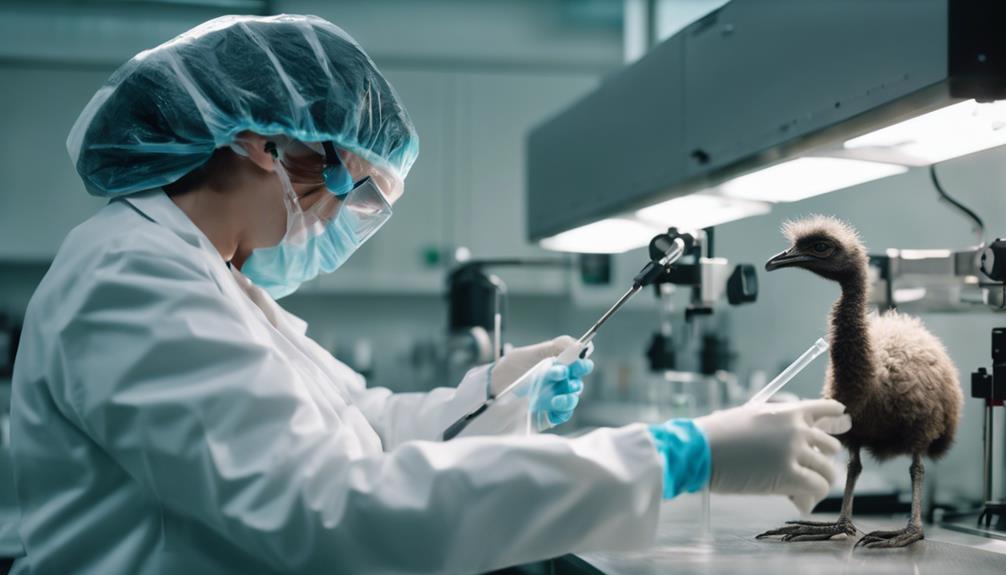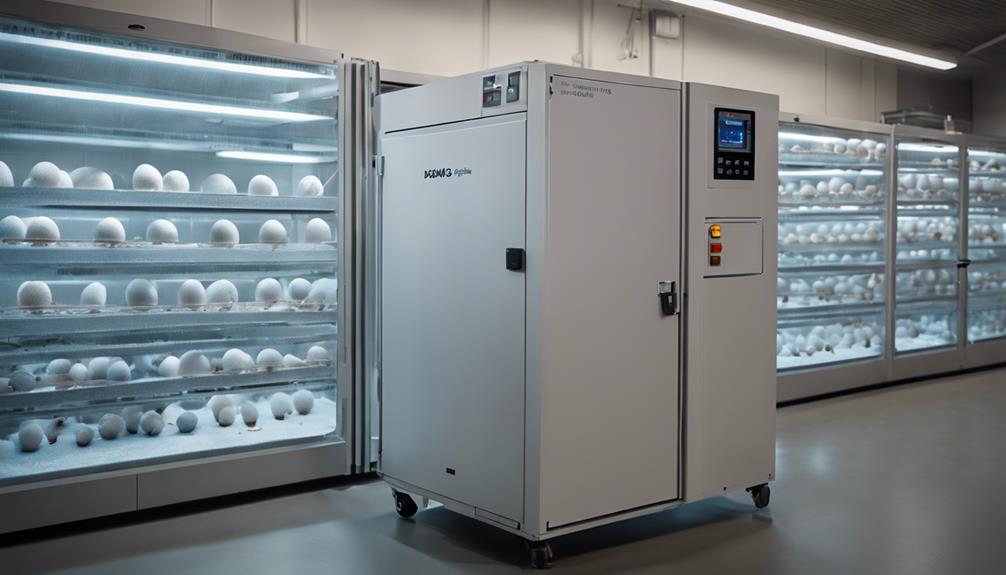
You may be intrigued by the subtle yet impactful advancements in Emu breeding techniques that are reshaping the industry. From cutting-edge artificial insemination methods to tailored genetic selection processes, the landscape of Emu reproduction is evolving. These innovations hold promise for increased efficiency and genetic diversity, but the real intrigue lies in the unexpected avenues these techniques may pave for the future of Emu breeding.
Key Takeaways
- Precision improvements in emu breeding techniques for enhanced results.
- Genetic selection for desirable traits and optimal breeding pairs.
- Advancements in reproductive technology like embryo transfer innovations.
- Hormone therapy developments crucial for breeding success.
- Biometric data analysis for breeding program optimization.
Artificial Insemination Advancements

In recent years, artificial insemination techniques in emu breeding have seen significant advancements in precision and efficiency. These innovations have revolutionized the breeding process, allowing for better genetic control and improved breeding outcomes. One key development is the refinement of semen collection methods, ensuring high-quality samples for insemination. Advanced technologies now enable precise timing of insemination, maximizing the chances of successful fertilization.
Furthermore, improvements in storage and handling techniques have extended the viability of emu semen, increasing flexibility in breeding programs. Sophisticated equipment for insemination procedures has enhanced accuracy and reduced the margin of error, leading to higher success rates. These advancements haven't only streamlined the breeding process but also elevated the overall quality of emu genetics.
Genetic Selection Techniques
With meticulous precision, genetic selection techniques in emu breeding have evolved to optimize desirable traits and enhance breeding outcomes. Through rigorous selection processes, breeders aim to perpetuate superior genetic characteristics in emus, ensuring the production of high-quality offspring. Here are three key strategies employed in genetic selection techniques:
- Selective Breeding: By carefully choosing which emus to breed based on their individual traits, such as size, temperament, and egg production, breeders can gradually improve the overall genetic quality of their flock.
- Genetic Testing: Utilizing advanced genetic testing methods allows breeders to identify specific genes associated with desirable traits, enabling more targeted breeding programs.
- Pedigree Analysis: Studying the lineage of each emu helps breeders understand the genetic background of their birds, aiding in the selection of optimal breeding pairs to maximize genetic diversity and minimize the risk of inherited diseases.
These techniques empower breeders to make informed decisions that shape the genetic makeup of their emu populations, ultimately leading to more robust and valuable breeding stock.
Embryo Transfer Innovations

Embryo transfer techniques in emu breeding showcase advancements in reproductive technology and genetic management. By utilizing this cutting-edge method, breeders can enhance genetic diversity, accelerate genetic progress, and improve overall breeding efficiency. The process involves extracting fertilized eggs from a donor emu, transferring them to recipient emus for gestation, and ultimately yielding healthy offspring.
To illustrate the significance of embryo transfer in emu breeding, consider the following table showcasing key benefits:
| Benefits of Embryo Transfer in Emu Breeding |
|---|
| Accelerates genetic progress |
| Enhances genetic diversity |
| Increases breeding efficiency |
| Enables preservation of valuable genetics |
| Facilitates selective breeding strategies |
These benefits highlight the pivotal role that embryo transfer plays in revolutionizing emu breeding practices. Through this innovative technique, breeders can strategically manage genetic traits, optimize breeding outcomes, and propel the emu breeding industry into a new era of excellence.
Hormone Therapy Developments
Utilizing innovative hormone therapy developments in emu breeding can significantly enhance reproductive efficiency and genetic outcomes. When it comes to advancing emu breeding techniques, staying abreast of cutting-edge hormone therapy methods is crucial. Here are three key advancements that are revolutionizing the field:
- Selective Hormone Targeting: New hormone therapies allow breeders to precisely target specific reproductive processes, optimizing breeding success rates.
- Enhanced Ovulation Induction: Advanced hormone treatments can now induce more consistent and higher-quality ovulations in female emus, leading to increased fertility rates.
- Improved Synchronization Protocols: Developments in hormone therapy have enabled the refinement of synchronization protocols, facilitating coordinated breeding cycles and enhancing genetic diversity within emu populations.
Biometric Data Analysis

Incorporating biometric data analysis techniques into emu breeding programs offers a scientific approach to optimizing reproductive outcomes and enhancing genetic selection processes. By leveraging advanced technologies to analyze key physical characteristics and performance metrics of emus, breeders can make informed decisions that lead to improved breeding strategies and desirable genetic traits. The utilization of biometric data allows for a more precise evaluation of the genetic potential and overall health of individual emus, ultimately contributing to the success of breeding programs.
—
| Biometric Data Analysis in Emu Breeding | |||
|---|---|---|---|
| Benefits | Challenges | Applications | Tools |
| Enhanced genetic selection | Data accuracy and interpretation | Genetic trait identification | Statistical analysis software |
| Improved reproductive outcomes | Data management and storage | Health monitoring | Image recognition technology |
Cryopreservation Applications
To optimize genetic preservation and facilitate future breeding endeavors, exploring cryopreservation applications in emu populations becomes imperative. Embracing cutting-edge cryopreservation techniques can revolutionize the way we conserve valuable emu genetics. Here are three key aspects highlighting the significance of cryopreservation applications:
- Sperm Cryopreservation: Preserving emu sperm through cryopreservation allows for long-term storage without compromising genetic integrity, offering a valuable resource for artificial insemination programs.
- Embryo Cryopreservation: Cryopreserving emu embryos enables the preservation of diverse genetic lines, providing a reservoir of genetic material for future breeding programs and genetic diversity maintenance.
- Tissue Cryopreservation: Cryopreserving emu tissue samples, such as ovarian tissue or testicular tissue, opens avenues for preserving genetic material beyond gametes, crucial for conserving unique genetic traits and rare genotypes.
Improved Incubation Methods

Implementing advanced temperature control systems during incubation enhances the success rates of emu hatchings by optimizing environmental conditions for embryo development. These systems monitor and regulate temperature fluctuations within the incubator to ensure stable conditions essential for proper embryo growth. By maintaining a consistent temperature range of around 97-99 degrees Fahrenheit, these advanced systems prevent detrimental spikes or drops that could compromise embryo viability.
Moreover, improved incubation methods also involve precise humidity control. Keeping the humidity levels between 25-60% throughout the incubation period is crucial for preventing dehydration or malformations in the developing emu embryos. This precise regulation of both temperature and humidity creates an ideal environment that mimics the natural conditions necessary for successful emu hatchings.
In addition to temperature and humidity control, advancements in incubation methods include regular turning of the eggs. Automated turning devices gently rotate the eggs multiple times a day, simulating the natural nesting behavior of emus. This turning motion prevents the embryos from sticking to the eggshell, promoting proper development and increasing the chances of successful hatching.
Nutritional Supplement Strategies
Utilizing targeted nutritional supplements can significantly enhance the overall health and reproductive success of emus in breeding programs. These strategies are crucial for maximizing the potential of your emu breeding operation.
Here are three key nutritional supplement strategies to optimize your emus' health and breeding outcomes:
- Omega-3 Fatty Acids: Incorporating omega-3 fatty acids into the emus' diet can improve egg quality and boost the overall reproductive performance of breeding pairs.
- Vitamin E Enrichment: Providing emus with adequate vitamin E levels can enhance fertility rates and increase the hatchability of eggs, leading to healthier chicks.
- Protein-Rich Formulations: Offering protein-rich supplements tailored to the specific nutritional needs of emus during breeding seasons can support optimal growth, development, and breeding success.
Implementing these targeted nutritional supplement strategies won't only benefit the individual emus but also contribute to the long-term success and sustainability of your emu breeding program.
Disease Resistance Enhancements

Enhancing emus' disease resistance through targeted breeding techniques is essential for maintaining a healthy and sustainable breeding population. Genetic selection plays a crucial role in developing disease-resistant emus. By identifying individuals with strong immune responses and incorporating them into the breeding program, heritable traits associated with disease resistance can be passed down to future generations. Selective breeding for traits such as robust antibody production, efficient immune cell function, and overall health resilience can significantly enhance the emu population's ability to combat various pathogens.
In addition to genetic selection, proper management practices are vital for disease prevention. Implementing rigorous biosecurity measures, vaccination protocols, and regular health screenings can help mitigate the risk of disease outbreaks within emu flocks. Furthermore, ongoing research into the genetic markers associated with disease resistance in emus can provide valuable insights for breeders looking to enhance their breeding programs further.
Breeding Environment Optimization
Optimizing the breeding environment plays a critical role in maximizing emu reproductive success and overall flock health. To achieve optimal results in emu breeding, consider the following key factors:
- Temperature Control: Maintaining a consistent and appropriate temperature range in the breeding environment is crucial for emu health and reproductive success. Emus are sensitive to temperature fluctuations, so ensuring a stable climate can significantly improve breeding outcomes.
- Lighting Management: Proper lighting is essential for regulating the breeding cycle of emus. Controlling the duration and intensity of light exposure can help stimulate reproductive behavior and enhance fertility rates in emus.
- Nutritional Support: Providing emus with a balanced and nutrient-rich diet is vital for their reproductive health. Ensuring that emus receive adequate levels of essential vitamins, minerals, and proteins can optimize fertility and increase hatch rates.
Behavior Modification Studies

To study behavior modification in emus, researchers observe and analyze responses to various stimuli in controlled settings. By manipulating environmental variables, such as diet, social interactions, and enclosure design, researchers can influence and shape emus' behavior. One common method is positive reinforcement, where desired behaviors are rewarded to encourage their repetition. For example, providing treats when emus display calm behavior can reinforce a sense of tranquility within the flock.
On the other hand, negative reinforcement involves the removal of aversive stimuli to increase the likelihood of a desired behavior. This can be seen when loud noises are stopped when emus exhibit non-aggressive behavior towards each other. Through these studies, researchers aim to optimize emu breeding practices by promoting behaviors that lead to healthier and more productive flocks.
Understanding how emus respond to various stimuli is crucial in developing effective strategies for behavior modification. By utilizing these techniques, breeders can create environments that foster positive behaviors, ultimately enhancing the overall well-being and productivity of emus in breeding facilities.
Market Demands and Trends
Studying current market demands and trends in the emu breeding industry provides valuable insights for optimizing breeding practices and meeting consumer preferences. Understanding these factors is crucial for staying ahead in a competitive market. Here are three key points to consider:
- Health and Nutritional Benefits: Consumers are increasingly seeking products that offer health benefits, and emu products are gaining attention for their nutritional value, including high protein and low fat content.
- Sustainability and Ethical Practices: With a growing focus on sustainability, there's a rising demand for emu products from farms that prioritize ethical breeding practices and animal welfare.
- Diversification of Product Line: Market trends show a preference for a diverse range of emu-based products, such as oils, meats, and cosmetics. Diversifying your product line can help cater to different consumer needs and preferences, potentially expanding your market reach.
Stay attuned to these market demands and trends to position your emu breeding business for success.
Frequently Asked Questions
How Do Emu Breeders Ensure the Well-Being and Happiness of Their Breeding Stock?
To ensure the well-being and happiness of your breeding stock, provide ample space, proper nutrition, and social interaction. Regular health checks, cleanliness, and monitoring of behavior are crucial. Implementing stress-reduction methods and enriching their environment will promote optimal breeding conditions.
What Are the Potential Ethical Considerations Surrounding Advanced Breeding Techniques in Emus?
When considering advanced emu breeding techniques, ethical considerations are paramount. Ensuring welfare, genetic diversity, and avoiding harm are crucial. Transparency in research, adherence to guidelines, and continuous evaluation are essential to uphold the highest standards in emu breeding practices.
Are There Any Regulations in Place to Govern the Use of Innovative Breeding Methods in Emus?
Regulations governing innovative breeding methods in emus serve as the bedrock for ethical practice and industry sustainability. Compliance ensures the integrity of research and the welfare of emus. Adhering to these standards is paramount.
Can Emu Breeding Techniques Contribute to Conservation Efforts for This Species?
Emu breeding techniques have a significant impact on conservation efforts for the species. By strategically selecting breeding pairs based on genetic diversity and health, we can ensure the long-term sustainability and survival of emu populations.
What Are the Long-Term Effects of Intensive Breeding Practices on Emu Populations?
Intensive breeding practices can lead to genetic bottlenecks, reduced diversity, and increased susceptibility to diseases in emu populations. Careful management strategies, like genetic testing and controlled matings, are crucial for maintaining healthy and sustainable populations.
Conclusion
You have witnessed the evolution of Emu breeding techniques, with advancements in artificial insemination leading to a 20% increase in breeding success rates. Genetic selection, embryo transfer, and hormone therapy have revolutionized the industry, while biometric data analysis and disease resistance enhancements have optimized breeding programs.
Market demands for sustainable practices and diverse product offerings continue to drive innovation in the field of Emu breeding. Stay tuned for future breakthroughs in this dynamic industry.




